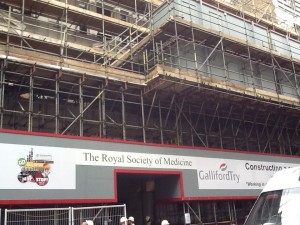On Thursday 10th May, I attended the centenary meeting of the ophthalmology section of the Royal Society of Medicine, in which the subject of ophthalmic lasers was addressed. The RSM is situated in a lovely building in Wimpole Street but is currently covered in scaffolding.
This didn’t detract from the meeting itself which broadly looked at the latest kid on the block, namely “femtosecond cataract” laser and a slight older laser “selective laser trabeculoplasty” (not much used in the UK). We use the latter in our practice here in Maidstone and have found it particularly useful for patients with early glaucoma or ocular hypertension. The presenters at the RSM were equally pleased with their results. We have found that one of the main benefit of SLT is the ability to keep patients off drops for months to years at the beginning of treatment. SLT is largely free of complications. The only significant problems have been the development of bleeding in 4 reported cases (out of millions of treatments) and intraocular pressure spikes in patients with very pigmented internal drainage angles.
The same cannot be said for the femtosecond laser which is being touted by industry as the new “improved” way of doing cataract extractions. The RSM speakers reported the problems early adopters had experienced in their patients. The worst of these seems to have been a high frequency of “lens drop”. This much feared complication has to be addressed before this laser can be promoted as being safer than conventional cataract surgery. The other major issue with femtosecond cataract surgery is cost – femtosecond cataract surgery is currently about £1000 more expensive per operation. The cost:benefit ratio of femtosecond cataract surgery doesn’t stack up at present.
All in all, ophthalmology has come a long way in the last 100 or so years. Probably the most striking advance was the development of the slit lamp by Gullstrand in 1911, which we still use many times a day in our ophthalmic practices. I wonder if we will still be using the femtosecond laser in 100 years time.


